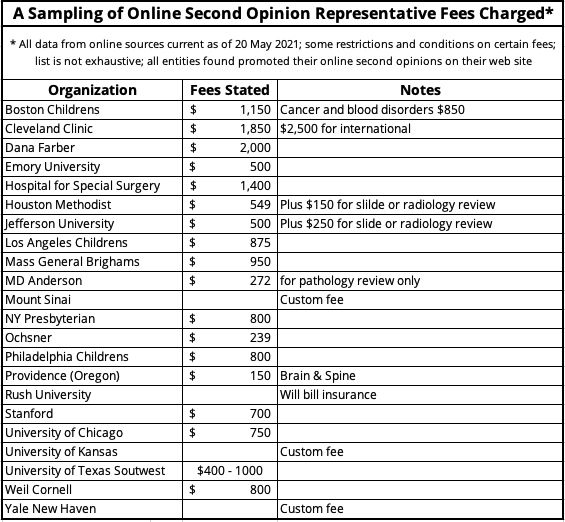Are Medical Second Opinions Profitable?

What is a second opinion?
Second opinions are becoming a popular procedure for anyone who receives a critical diagnosis that does not require immediate emergency action. Informed patients realize that the diagnosis of any individual physician is not infallible. Two heads are always better than one!
Physicians realize that having more than one review is appropriate for most patient diagnoses. It’s not uncommon for your physician to be the one who suggests a second review. With their growing popularity, it’s no surprise that an increasing number of providers and healthcare organizations are standing up formal second opinion practices to cater to these patients.
The majority of providers do these consults in person, however, a growing number of providers are enabling patients to receive these second opinion diagnoses remotely. For those who find it difficult or inconvenient to travel, sometimes long distances, to receive a second opinion, one done virtually is often a very viable option. In such a case, the remote physician reviews the original test results and opinion the patient already received and issues their own informed subsequent opinion. These are called online or virtual second opinions.
How is a virtual second opinion different than one in-person?
The biggest difference between a virtual and in-person second opinion is that when done remotely, no live tests or examinations are performed. Instead, the second opinion physician relies on the patient's existing medical history.
Virtual or online second opinions are performed asynchronously, and sometimes include a virtual consult with the care team. What this means for the patient is that there is no obligation to travel from their home or out of their state. This flexibility expands the availability of specialists wherever they may be located.
The result received by a patient usually comes in the form of a written report that may be coupled with a video consult. More often than not, the diagnosis and treatment plan will be delivered to both the patient and his or her local physician to ensure that any prescribed treatment can be effectuated by someone local to the patient.
How much should I charge for a Remote Second Opinion?
The fees for second opinions range from a low of a couple of hundred dollars to $2,000 or more. Some vary based upon offering multidisciplinary reviews. When you first stand up a remote second opinion practice, unless you are a world-renowned specialist in your field, you should expect to charge about $1,000. Here is a chart of the publicly available fees charged by some of the leading remote second opinion programs as of the date of this article.

What Are the Expected Costs?
You’ll obviously want to compare the fees you can charge against your expected costs. There are several categories of direct costs associated with rendering a second opinion. These include administrative costs, technology expenses, marketing, and compensation for physicians who participate. Some of these costs will vary, depending upon the level of effort. Your per-case costs will vary dependent upon your volume of cases.
Case Administration Fees
The direct incremental cost of personnel or a third-party administrator will range between $250-650 per case. It is likely that you will need to hire a new administrator, perhaps trained as a clinician, to manage this program internally or at least use the services of an existing staff member, even if you use a third-party administrator. Most of this cost is attributed to the time and effort required to collect the patient’s prior medical records and organize them in a fashion conducive to your specialist’s review.
Marketing
You can expect to spend several thousand dollars to set up or edit your website to reflect this new service offering. More will need to be spent on the normal marketing expenses associated with any new offering for your organization. Marketing costs may range from very little incremental cost to tens of thousands of dollars for content development, search engine optimization (SEO), and promotion.
Technology
There are several choices that you have in procuring a purpose-built second opinion software. You should expect to spend in the range of $50,000 per year for a good system. Expect to incur additional one-time fees that will depend upon your specific systems and the intricacy of your integration to enable your second opinion system to send cases and patient data directly to your downstream systems such as your EHR or PACS.
Compensation for Physicians
Some organizations have found it advantageous to provide a stipend to physicians who participate in your second opinion program. Since in most cases, the physicians will do this in addition to their day jobs, organizations may decide to provide a per case stipend of as much as $500. However, most pay much less than that, if anything at all.
Your Budget
We believe an organization considering a remote second opinion system should consider a budget that looks like the following:
Fixed Costs (annually)
Personnel $80,000
Technology $50,000
Marketing $10,000
Per Case Fees
Administration $ 350
Physician Stipend $ 250
Assuming you average 5 cases per month for your first year, the cost per case amounts to almost $3,000. Unless your volume increases substantially, it will be difficult to generate direct profits from this type of program unless you decide to set your patient fees at the high end of the range. But this alone shouldn’t prevent you from considering standing up a remote second opinion program.
Extrinsic Value
The real value of a remote second opinion program is based upon the overall impact on your organization as well as the expansion of your organization’s reach. While the above financial analysis may seem disappointing, you should consider the following extrinsic values to your organization of having such a program.
Building your Brand
One of the best ways to promote your expertise is to focus your second opinion practice on one or a few of your current outstanding specialties. Almost every organization already has a specialty for which they are already known at least within their current markets. Exposing this specialty more widely using a remote second opinion program is a way to enable your organization to stand out in an increasingly competitive market. The value of doing so can be immeasurable.
Attracting In-Patient Procedures
A very direct financial benefit of standing up a remote second opinion practice relates to the incremental patient procedures that will result from the second opinions you render. It is still early in the adoption of second opinion practices, however, initial statistics indicate that a substantial percentage of second opinion patients will consider your facility for their treatment. A couple of in-patient procedures or admissions will have a material impact on the return on your investment.
Retaining High Caliber Talent
With competition for specialty talent increasing, one way to enable a smaller market specialist to stand among amongst his or her peers is to accentuate that specialty as a promoted second opinion. We are finding that narrow specialty expert physicians often naturally gravitate to the larger population markets. However, there are many talented individuals who would prefer to reside in smaller markets as long as there is sufficient demand for their specialty.
Are you ready to make this investment?
You need to decide both if you are willing to make the initial investment necessary to launch a remote second opinion practice as well as if you expect the return on your investment would be worthwhile. Standing up a remote second opinion practice is hard work. However, more and more hospitals and health care organizations are adopting this practice as a way to bolster their stature and their long-term financial performance.




